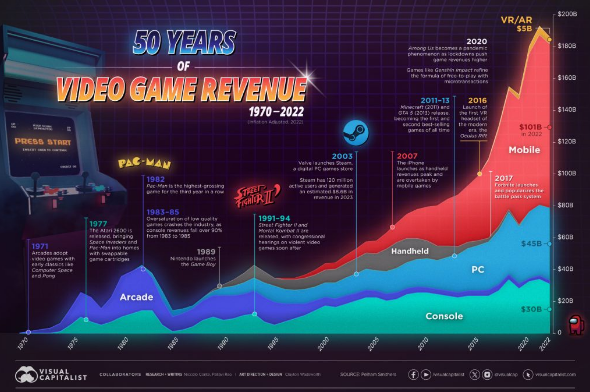Connection to DriversCloud Create a DriversCloud.com account Reset your DriversCloud.com password Account migration
50 years of video games in sales: mobile, by far number one
Over the past 50 years, the video game industry has changed radically. An infographic takes stock of this short history of a hobby that has become a giant.
The Visual Capitalist website takes us on a fascinating journey through the history of video games. To arrive at this rich infographic, the authors drew their data from the British institute Pelham Smithers, which compiled a wealth of information on the revenues of the various players in the world of video games. By sorting the data by platform and by year, we were able to chart the 50-year history of video games, from their emergence in the early 70s to the very end of 2022.
Logically, things got off to a smooth start in 1971 and 1972 with the releases of Computer Space and Pong. Founded by Nolan Bushnell and Ted Dabney, it was the Atari brand that put the whole industry on the right track. Little by little, things began to take off, first in what would soon become the arcades, and then directly into the living rooms of American homes with the first video game consoles. The latter had only a handful of built-in games, and it wasn't until September 1977, with the release of what was then known as the Atari VCS(Video Computer System), that the first machine adopted the cartridge system. The machine was launched... perhaps a little too quickly. 1982 was marked by the exceptional success of the Atari VCS and the Pac-Man game, but too many players wanted a piece of this delicious cake. Production exploded, but quality failed to keep pace, and the crash of 1983-84 brought everyone to their senses: revenues for the industry as a whole plummeted from $42 billion in 1982 to less than $18 billion in 1985.
1985 marked the beginning of the recovery. This slow recovery was largely due to the success of a newcomer to the industry, Nintendo. The NES console revitalized an entire economy, while at the same time, the rise of personal computers and PCs in particular created a new market. 1989 marked the beginning of the handheld console era. A parenthesis? Yes, because even though it lasted until 2018, it soon came up against competition from mobile gaming, on phones and then smartphones. A competition that very quickly enabled this emerging market to become the most profitable - by far - of the entire video game sector. Today, it accounts for $101 billion in sales, with an estimated market share of 55.3%. In second place is the PC, long described as moribund, which still accounts for 24.5% of the market, with sales of $45 billion.
Incidentally, these revenues are calculated on the basis of software alone. Hardware sales, which are highly profitable on PCs, are not taken into account. In third place is the home console sector, with $30 billion or 16.6% market share. Closing the gap is the nascent virtual reality sector. It remains far behind the others, with just 2.5% market share and revenues of $5 billion. Finally, the arcade world is reduced to its simplest expression, with a handful of arcades remaining around the world, with a market share of 1.1% and annual revenues of less than $2.5 billion.






